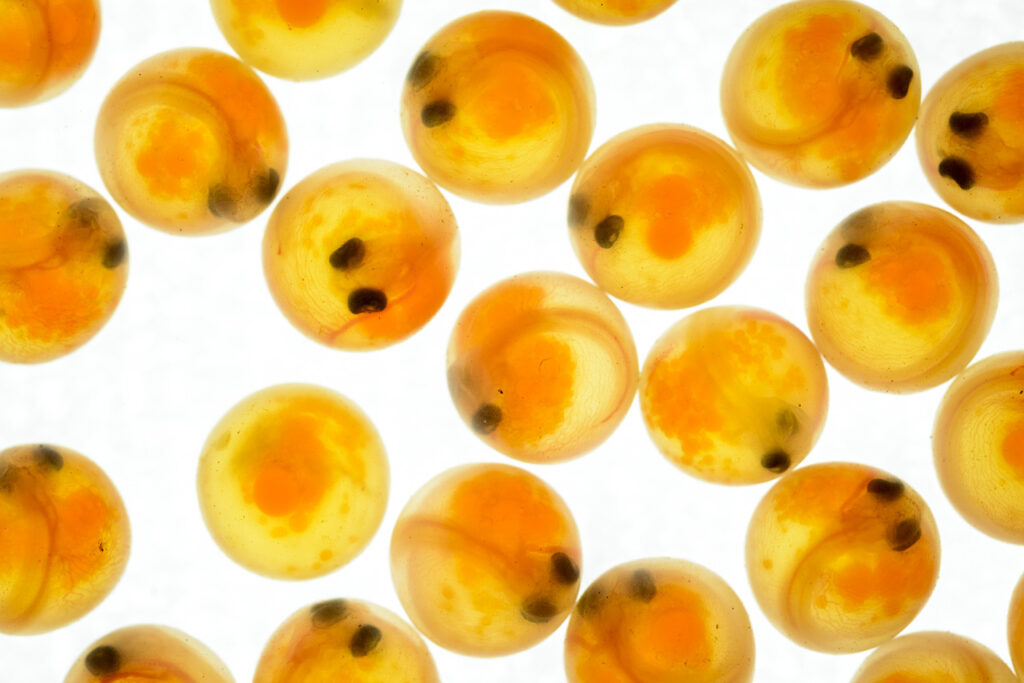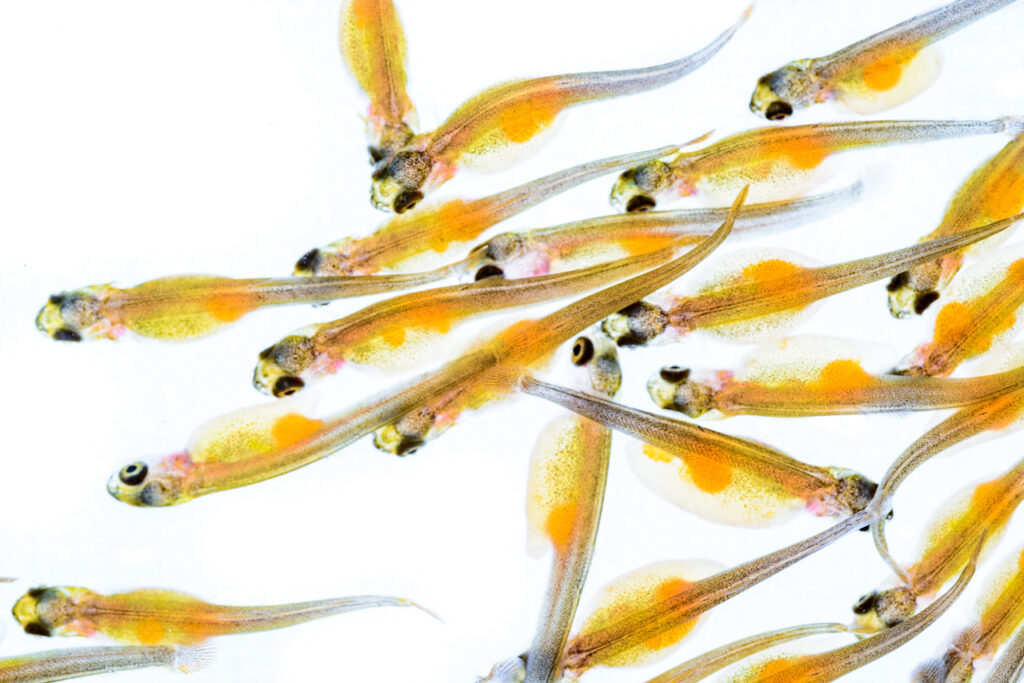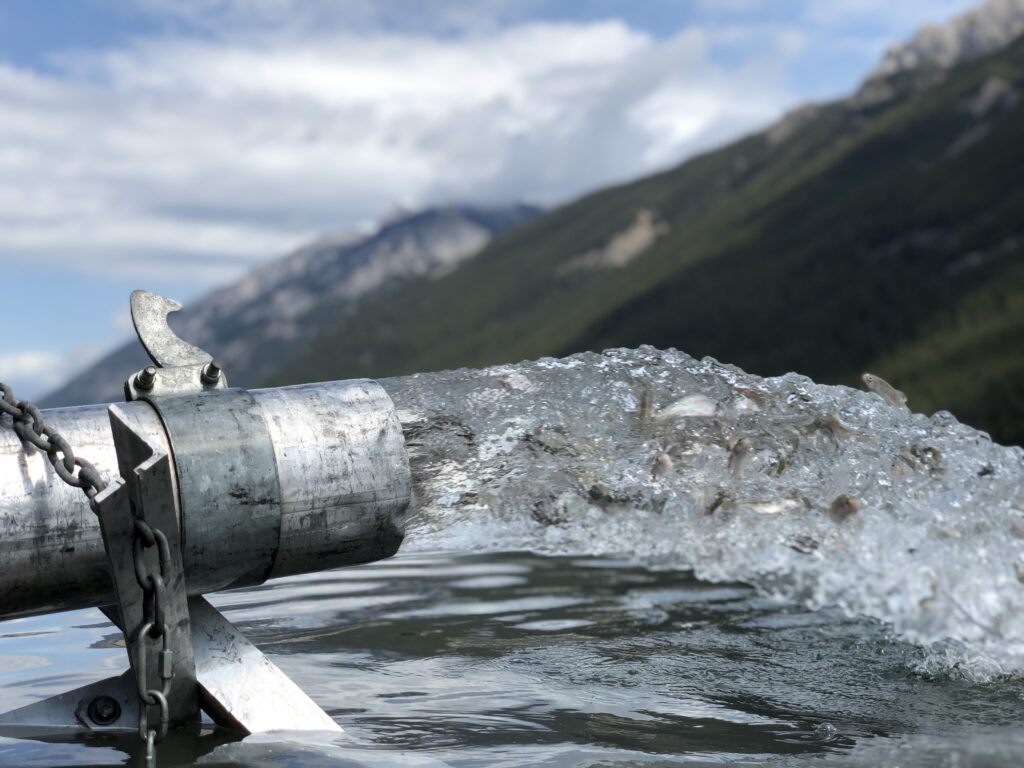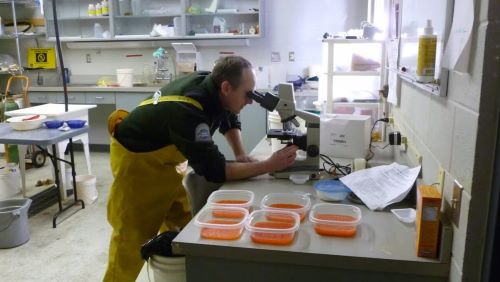The Freshwater Fisheries Society of BC is continually researching options to improve the growth, survival, and quality of the freshwater fish stocked into British Columbia’s lakes and rivers. These efforts contribute to improving recreational fishing and minimizing impacts to wild fish populations and biodiversity. Specifically, sterility, all-female technologies and fish size at stocking are a few of the research areas contributing to stocked fish performance and have direct benefits to the fishery and protect wild fish populations.
Triploid (3n) fish
This technology involves a sterilization process that is unique to each species of fish. Such treatments increase the cost on a per-fish basis, but the fishing benefits can be substantial. Currently, approximately 50% of the small lakes in B.C. are stocked with triploid fish. The Freshwater Fisheries Society produces triploid rainbow trout, eastern brook trout, kokanee, and cutthroat trout.
Benefits of sterility (3n):
- Triploid fish may live longer than diploid fish as they are not subject to increased mortality associated with the process of maturation and/or spawning.
- It can result in a higher number of larger “bright” fish being available to the fishery.
- It reduces the risk of genetic interactions between hatchery and wild fish.
- It prevents the establishment of hatchery-origin populations in areas of conservation or biodiversity concerns.


What’s involved?
Triploid fish are not Genetically Modified Organisms (GMOs). GMOs have had their DNA molecules altered by genetic engineering to insert or remove foreign pieces of DNA that don’t come from that organism. Triploidy, in contrast, just means that the organism has one additional (but identical) set of chromosomes compared to the usual compliment of two sets in diploid organisms (i.e. 3n versus 2n). Triploidy can occur naturally in salmon and trout (albeit at very low rates). This condition results in reproductive sterility. Currently the Freshwater Fisheries Society induces triploidy through the application of hydrostatic pressure to the eggs shortly after fertilization. This technique results in the retention of the second polar body normally extruded shortly after fertilization, resulting in a third set of chromosomes instead of the usual two sets. This triploidy method achieves a 98-100% sterility rate in our facilities. The result is sterility in both males and females. No genetic material is introduced, moved or taken away. The fish are not “genetically modified” in any way.
Sterilization (i.e. triploidy) manifests itself differently depending on the sex of the fish. Female triploids are hormonally and functionally sterile (i.e. no development of functional oocytes (eggs), and no behavioral changes). Male triploids are sterile, but still produce hormones that cause changes associated with maturation including deterioration of flesh quality, the development of testes and other secondary sex characteristics and early mortality. Sterile males also demonstrate spawning behaviour including migration and interactions with other fish on the spawning beds regardless of their inability to reproduce. This behaviour may displace functionally reproductive wild males and affect the fitness of the wild population.
All-Female (AF) fish
The development and maintenance of all-female broodstock occurs in a captive environment. The technique is well-established for rainbow trout and brook trout and is more recent for kokanee.
Benefits of AF production:
- Females generally delay the maturation process for a year or longer after males. This delay benefits females in two ways: they allocate more of their energy to growth (instead of gonad development); and they are not subjected to the increased mortality associated with maturation. Effectively this leads to an increased abundance of older and larger fish with higher flesh quality in the fishery.
- The stocking of all-female progeny in the absence of males effectively creates a functionally non-reproductive population (assuming this population is isolated from wild populations).
What’s involved?
The Freshwater Fisheries Society produces all-female populations of fish by crossing sex-reversed females with normal females. To create sex-reversed females female fry are exposed to testosterone derivatives to halt ovary development and produce normal testes. The sperm must be extracted by hand as these fish generally do not develop a sperm duct. Once mature, they are crossed with wild females to create all-female progeny for stocking.
All-Female triploid (AF3n) fish
This process combines both triploidization and all-female technologies to produce AF3n fish for stocking. The production of AF3n fish for stocking derives the benefits of both the process of “feminization” and triploidization (AF and 3n).
Benefits of AF3n production:
- The greatest benefit of the double treatment (AF3n) is that it addresses conservation concerns (see Benefits of Sterility) and provides fisheries benefits of avoiding stunting and loss of fish from the fishery associated with early maturing males (see Benefits of AF).
- In addition, AF3n reduces the risk of interfering with wild fish spawning behaviour because there will be no males present.
Stocking sizes
Fisheries managers can improve small lake fisheries by matching specific lake characteristics with the appropriate strain and stock selection, stocking rates and regulations. Fish size at stocking is another consideration to improve fish performance. The size a fish can be reared to in a hatchery facility is limited to some extent by tank space and other economic constraints. However, there may be some situations that warrant size consideration:
- In lakes that only contain trout species, survival of fish released at small sizes (fry) is very good and surviving long enough to benefit the fishery is very likely.
- In mixed species lakes with non-salmonid competitors or predatory fish species, size-at-release is more important. Fish stocked at a larger size may have increased potential to compete for food resources and/or avoid predation.
- Heavily used urban fisheries may require multiple stockings in a single season to keep up with demand. Therefore, fish are released at a large size that makes them immediately “catchable”.
- Similarly, lakes that regularly winterkill may not be able to retain fish for multiple years to support growth over time and may also be stocked with catchable sized fish.


Author: Staff, Freshwater Fisheries Society of BC
Banner Photo Credit: Verna Cameron
